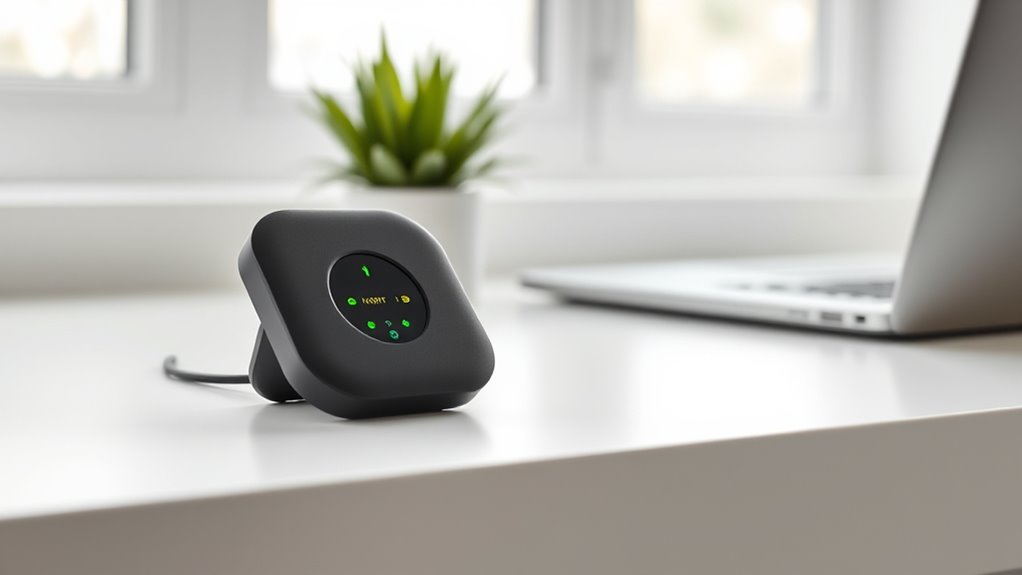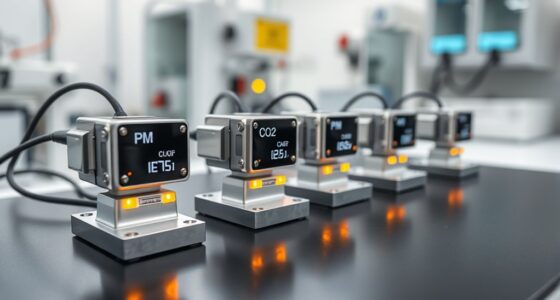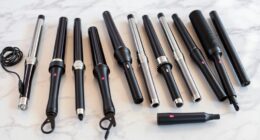Low-cost indoor air quality sensors can be quite reliable when properly calibrated and combined with data integration, giving you an accurate picture of your home’s environment. They monitor pollutants, humidity, and temperature, helping you identify issues early and automate air quality improvements. While not as precise as industrial sensors, their affordability makes them accessible for everyday use. If you continue exploring, you’ll discover how to maximize their effectiveness and applications for safer, healthier indoor spaces.
Key Takeaways
- Proper calibration of low-cost sensors ensures accurate indoor air quality measurements by correcting manufacturing variances.
- Data integration from multiple sensors provides a comprehensive and reliable picture of indoor air conditions.
- Regular maintenance and calibration are essential to maintain the reliability of affordable air quality sensors.
- These sensors are suitable for monitoring allergens, VOCs, humidity, and temperature in variable indoor environments.
- Although less precise than industrial-grade sensors, proper calibration and data management enhance their effectiveness.

Have you ever wondered how clean the air inside your home truly is? If you’re like most people, you probably rely on your senses or maybe basic detectors to gauge air quality. But low-cost indoor air quality sensors are changing that. They offer an affordable way to monitor pollutants, humidity, temperature, and other air factors continuously. However, to guarantee these sensors provide accurate readings, proper sensor calibration is essential. Calibration involves adjusting the sensor’s output to match known standards, which helps eliminate inaccuracies caused by manufacturing variances or environmental factors. Without proper calibration, data from these sensors can be misleading, leading you to false conclusions about your home’s air quality. That’s why many advanced low-cost sensors incorporate automatic or manual calibration features, making it easier for you to maintain their accuracy over time.
Another critical aspect is data integration. When you have multiple sensors installed around your home, integrating their data allows you to get a complete picture of your indoor environment. Data integration combines outputs from different sensors into a unified system, making it easier to analyze trends, identify sources of pollutants, and take appropriate action. Many low-cost sensors are designed to connect seamlessly with smartphones, smart home systems, or cloud platforms, enabling real-time monitoring and alerting. This interconnected approach simplifies managing air quality, especially if you want to automate ventilation or air purification systems based on sensor readings. Furthermore, integrating data from various sensors helps compensate for individual sensor inaccuracies, as cross-referencing data can reveal inconsistencies or calibration drift. This continuous data stream ensures you’re always aware of your indoor air status, allowing you to respond promptly to any issues.
The reliability of low-cost sensors depends heavily on these factors—sensor calibration and data integration. When properly calibrated, these sensors can deliver trustworthy data that reflects real conditions. Data integration enhances this reliability by providing context, reducing false alarms, and enabling smarter responses. Whether you’re concerned about allergens, volatile organic compounds, or humidity levels, these sensors can be powerful tools. They’re especially valuable in spaces where air quality may fluctuate, like homes with pets, smokers, or recent renovations. While they might not match the precision of high-end industrial sensors, their affordability, combined with good calibration and data integration practices, makes them effective for everyday use. By understanding and managing these aspects, you can confidently rely on low-cost indoor air quality sensors to keep your home safe, healthy, and comfortable for you and your family.
Frequently Asked Questions
How Do Low-Cost Sensors Compare to High-End Models?
You’ll find that low-cost indoor air quality sensors generally offer lower cost accuracy and durability compared to high-end models. While they perform well for basic monitoring, they might not be as reliable over time or in detecting precise pollutant levels. High-end sensors provide better performance and longevity, making them ideal for critical environments. However, if budget is a concern, low-cost sensors still deliver valuable insights with some limitations in accuracy and durability.
Can These Sensors Detect All Indoor Air Pollutants?
You can’t rely on low-cost sensors to detect all indoor air pollutants because of their sensor limitations. They are designed to identify common pollutants like VOCs and particulate matter but often miss gases like radon or formaldehyde at low levels. While useful for general air quality monitoring, you should understand these sensors have detection limits, and for extensive pollutant detection, more advanced, high-end equipment is typically necessary.
What Is the Typical Lifespan of Affordable Air Quality Sensors?
Affordable air quality sensors typically last around 2 to 5 years, depending on their sensor durability. You should expect to perform calibration more frequently as the sensor ages, usually every 6 to 12 months, to guarantee accuracy. Proper maintenance and regular calibration help extend the lifespan of your sensors and keep their readings reliable, making them a cost-effective choice for monitoring indoor air quality over time.
How Do Environmental Conditions Affect Sensor Accuracy?
Environmental conditions like humidity interference and temperature effects can greatly impact your sensor’s accuracy. High humidity may cause false readings or sensor drift, while extreme temperatures can alter sensor response times and sensitivity. To maintain reliability, you should regularly calibrate your sensors and consider environmental controls or protective enclosures. Monitoring these conditions helps ensure your air quality data remains precise and trustworthy, even in challenging indoor environments.
Are Low-Cost Sensors Suitable for Professional Air Quality Monitoring?
Imagine you’re in a vintage radio shop—low-cost sensors can be useful, but they aren’t quite professional-grade. They’re suitable for some applications, yet their cost limitations and calibration challenges mean they might not meet strict accuracy standards required for professional air quality monitoring. You should consider these factors before depending on them; for critical decisions, investing in higher-end sensors ensures more reliable, precise data, ultimately protecting health and safety.
Conclusion
Think of these low-cost sensors as the lighthouse guiding your home’s air quality through fog and darkness. They stand watch like silent guardians, revealing hidden dangers and illuminating safe spaces. With their reliability, you can navigate your environment confidently, ensuring fresh, healthy air flows freely. Embrace these humble sentinels—they symbolize your commitment to well-being, turning everyday spaces into safe harbors where clarity and health shine brightly, no matter how cloudy the air outside.










